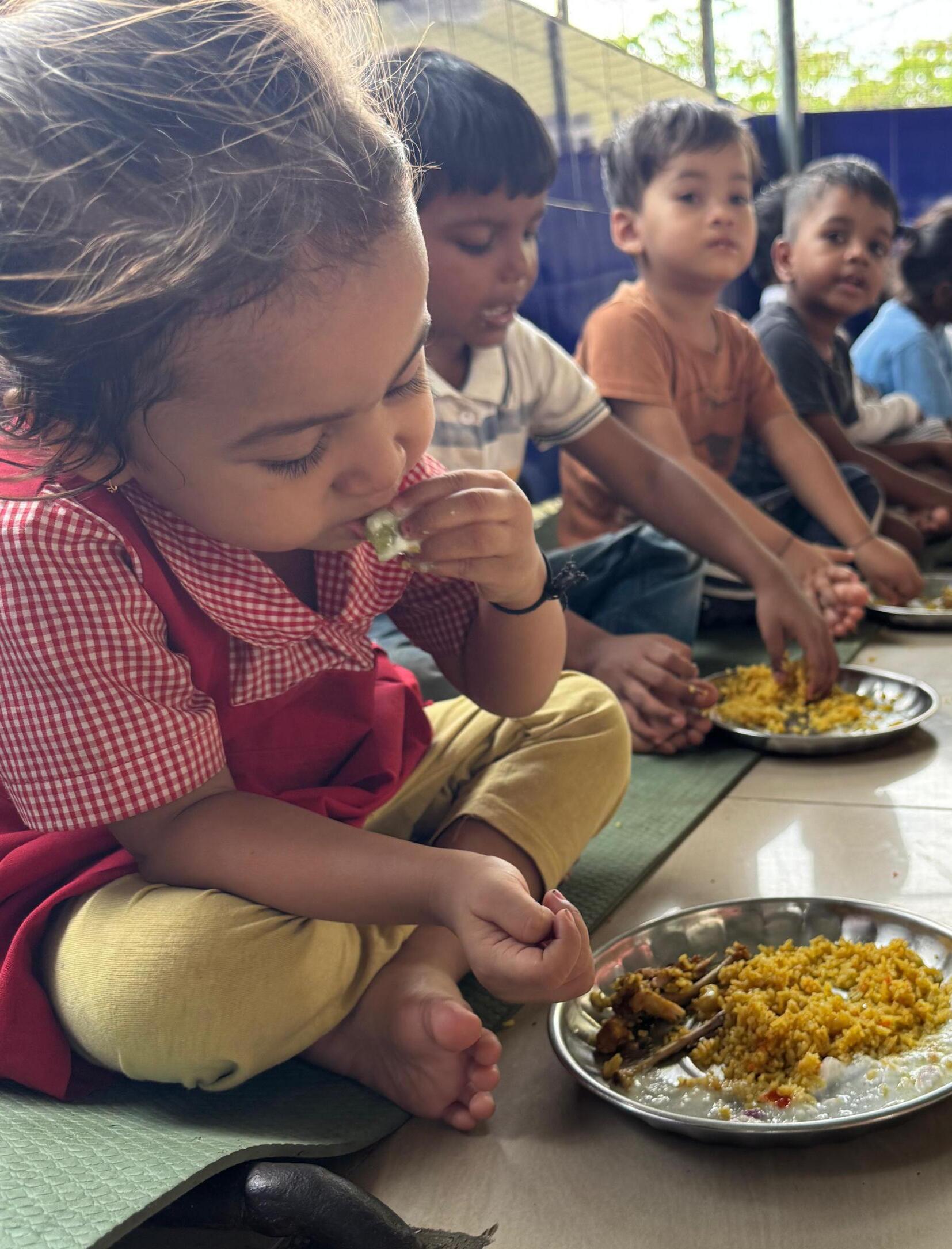












Marriott Goa Benaulim's 'Stotrees' Bloom with Wishes











ADITI MALHOTRA MANAGING EDITOR














Marriott Goa Benaulim's 'Stotrees' Bloom with Wishes











ADITI MALHOTRA MANAGING EDITOR
Hello, dear readers!
Summer has arrived—not suddenly, not loudly, but gently, like a quiet shift in rhythm. The mornings are brighter, the evenings linger a little longer, and there’s this unspoken agreement with yourself to take things just a bit slower. Maybe it’s the sun, maybe it’s the season, or maybe it’s just the way Goa does things—easing into every change with grace, never in a rush, always with a little time to spare.
There’s something about this time of year that softens everything. The food gets lighter, the drinks get colder, the conversations get deeper. The fruits of the season begin to appear in kitchens and on tables juicy mangoes, tart pineapples, sweet watermelons—reminding you that nature has its own way of celebrating. No frills, no fuss, just effortless abundance.
Summer in Goa is not about dramatic plans or grand gestures. It’s about slipping into the flow of the season. It’s about that 4 p.m. pause with a cold drink in hand, that impromptu plan that turns into a perfect evening, that feeling of barefoot ease as you move through the day. Even the celebrations take on a different tone—less noise, more intention. It’s not about doing everything, it’s about doing the things that matter, with the people that matter.
In a world that constantly nudges us toward productivity, summer asks us to rest. To savour. To find joy in a meal that’s uncomplicated but full of flavour, in a moment of silence between the music, in stories shared over clinking glasses and slow-cooked ideas. It’s a season that doesn’t demand—it offers. A little warmth, a little stillness, and a chance to recalibrate.
As we move through this issue, we carry that mood—of celebration, but not just in the usual sense. Celebration in the way we eat, the way we gather, the way we travel with curiosity, and the way we discover ourselves a little more with each season. Whether it's a new cocktail that surprises you, a faraway village that feels strangely familiar, or a gentle reminder to listen to your body—this month is about honouring the present moment.
Because sometimes, the most meaningful celebrations aren’t the loudest ones. They’re the quiet ones—the kind that arrive with a soft breeze, a full plate, and the knowing smile that says, this… this is enough.
With love and light,
Aditi






Editor in Chief & Publisher
Rajesh Ghadge rajesh@rajeshghadge.com
Managing Editor
Aditi Malhotra aditi@foodandhospitality.org
Contributors
Sunil Malhotra
Armaan Malhotra
Aakash Ghadge
Gauri Ghadge
Niharika Sachdeva
Saloni Pai
Design & Layouts
GPDM - A Media Company info@goaprism.com
Photography
Tanmayee Masurkar
Gauri Ghadge
Aakash Ghadge
EDITORIAL OFFICES
2nd Floor, Udyog Bhavan, Opp Azad Maidan, Panaji,Goa-403001

2nd Floor, Udyog Bhavan, Opp Azad Maidan, Panaji,Goa-403001 +91 8999085172 | info@foodandhospitality.org

SUBSCRIPTIONS & ADVERTISEMENTS
+91 8999085172 | info@foodandhospitality.org
The Magazine is Published by GOA PRISM DIGITAL MEDIA Rajesh Ghadge, RNI - GOAENG/2020/00441 www.fnhmag.com
2nd Floor, Udyog Bhavan, Opp Azad Maidan, Panaji,Goa-403001
Cover Photo Credits Image by Freepik Stock Images Credits Freepik



As summer rolls into Goa, so does the much-anticipated Urrak season, and Copperleaf Goa's acclaimed fine dining destination—is celebrating it in style. With outlets in Porvorim and Panaji, Copperleaf invites guests to discover the vibrant flavors of Goa's liquid gold through a range of Urrak-infused beverages that perfectly marry tradition with innovation.
For those unfamiliar with this seasonal sensation, Urrak is the first distillate of the cashew apple, a distinctly Goan spirit known for its light alcohol content, citrusy freshness, and fruity aroma. Unlike its stronger cousin Feni, which undergoes multiple distillations, Urrak retains a raw, almost tropical essence that is both rustic and refined. It is best enjoyed chilled, often paired with soda, lime, and a touch of salt or spice—but at Copperleaf, this classic has been elevated to an art form.
Known for blending heritage with haute cuisine, Copperleaf's
culinary team has curated a special Urrak menu that captures the spirit's natural vibrancy Using locally sourced ingredients like kokum, ginger, mint, tender coconut, and citrus infusions, each drink is handcrafted to deliver refreshment, character, and authenticity in every sip.
What sets Copperleaf apart is not just the ingredients—but the philosophy behind the mixology Instead of masking Urrak's identity, the bar team enhances it, letting the cashew apple's subtle fruitiness take centre stage The result is a range of cocktails that are crisp, clean, and unapologetically Goan.
Whether you ' re unwinding after a long day or looking to introduce friends to Goa's liquid culture, these cocktails are the perfect way to toast to summer.
Urrak is more than just a drink—it's a seasonal cultural moment. Its availability is limited to the short span of the cashew harvesting period, typically between March and early May. Once the season ends, so does access to this exclusive beverage.
That's what makes Copperleaf's Urrak offering so special: it's fleeting, rare, and worth savoring. The restaurant encourages patrons to come before the season ends, to sip on something that embodies the essence of Goa—sun-drenched orchards, traditional distilleries, and a spirit of celebration.
At a time when consumers are more curious about regional authenticity and seasonal ingredients, Copperleaf's approach is both timely and tasteful. By spotlighting Urrak in a refined dining environment, they're not just serving a drink—they're preserving a piece of Goan heritage. It's a nod to the past, served with modern flair.
So, if you're in Goa this summer, make your way to Copperleaf Porvorim or Panaji. Raise a glass to tradition, innovation, and everything in between. With every sip of their Urrak-infused creations, you ' re not just tasting a cocktail you ' re experiencing a story steeped in local culture.
Because in Goa, even the drinks have soul.














The Department of Tourism, Government of Goa has officially announced its participation in the 14th edition of the Great Indian Travel Bazaar (GITB) 2025, scheduled to take place from 4th to 6th May in Jaipur, Rajasthan. GITB, one of the country's most prestigious travel trade events, is jointly organized by the Government of Rajasthan, the Ministry of Tourism, Government of India, and the Federation of Indian Chambers of Commerce and Industry (FICCI). This strategic participation underscores Goa's ongoing efforts to establish itself as a year-round, globally attractive destination that goes far beyond its postcard-perfect beaches. As one of India's most iconic travel states, Goa is leveraging the GITB platform to connect with international tour operators, travel buyers, tourism boards, and key industry stakeholders, highlighting its evolving tourism ecosystem rooted in culture, sustainability, and diversity. Goa's pavilion at GITB 2025 will offer a holistic showcase of its tourism offerings—from heritage walks and vibrant festivals to hinterland adventures, nature escapes, wellness retreats, and regenerative tourism initiatives. The Department aims to highlight how Goa is innovating beyond traditional travel to become a model for responsible, experience-driven tourism. Speaking about the significance of Goa's participation, Shri Kedar Naik, Director of Tourism, said, “Goa's participation at GITB 2025 marks yet another opportunity to highlight the state's rich and multifaceted identity. While our beaches are world-famous, Goa is also a land of deep cultural roots, diverse ecosystems, and timeless traditions. From temples and forts to music, cuisine, and village life—there's a Goa for every kind of traveler.”
With growing global interest in slow travel, sustainable tourism, and immersive experiences, Goa's strategic positioning at GITB aligns perfectly with these emerging trends. The state will present not only its coastal charm but also its unique backwaters, rural circuits, adventure activities, ecotourism hubs, and heritage sites—all crafted to attract discerning travelers looking for more than the ordinary.
Delegates visiting the Goa Pavilion can expect engaging B2B meetings, business networking opportunities, and interactive sessions with senior tourism officials and hospitality partners. The aim is to foster dialogue around new initiatives, forge travel collaborations, and offer insights into curated travel itineraries designed for both domestic and international markets.
What makes this participation especially important is its continuity and consistency Goa has been a regular participant at GITB, and its representation has always drawn praise for being both informative and culturally immersive. This year, with added focus on sustainability, local entrepreneurship, and community-based tourism, the state hopes to set new benchmarks in travel promotion.
As the world rediscovers India's diverse tourism tapestry, Goa stands tall as a destination that blends the past with the present, the serene with the festive, and the luxurious with the authentic.
Goa Tourism warmly invites all travel professionals, buyers, and stakeholders to visit its pavilion at GITB 2025 and explore the many compelling stories that make Goa not just a place to visit, but a place to experience, connect with, and cherish.



Absolute Hotel Services (AHS) India has announced the appointment of Mr. Dinesh Dahiya as Deputy Vice President –Commercial, bringing on board a seasoned hospitality professional with over 25 years of distinguished industry experience This strategic move reinforces AHS India’s commitment to strengthening its commercial leadership and driving sustainable growth across its expanding portfolio.
An Award-Winning Hospitality Veteran
Mr. Dahiya has built an impressive career, having held senior leadership roles at Starwood Hotels, Radisson Hotel Group, Accor, Fern Hotels, and Sayaji Hotels. Renowned for his
expertise in business development, revenue management, and sales strategy, he has consistently delivered transformative results, earning him a reputation as one of the industry's most dynamic commercial leaders.
His accolades include:
Most Fabulous Leaders Award – Global MICE & Luxury Travel Congress & Awards (2020)
Hospitality Superstars Award (2019)
Enterprising Director of Sales & Marketing Award – Hospitality & Travel Awards (2019)
These recognitions stand as a testament to his ability to exceed ambitious goals, foster high-performing teams, and drive exceptional outcomes for hospitality brands.
Driving Growth with Vision and Precision
In his new role, Mr. Dahiya will lead the commercial strategy for AHS India, focusing on revenue optimization, market expansion, hotel acquisitions, and strategic partnerships. His strong understanding of hotel management contracts, feasibility assessments, and commercial operations makes him ideally suited to support AHS’s vision of delivering bespoke hospitality solutions across South Asia.
Leadership Endorsement and Future Outlook
Shalil Suvarna, Senior Vice President –Operations, Absolute Hotel Services India & South Asia, shared his confidence in the appointment:
“Dinesh Dahiya’s proven track record and award-winning leadership make him the perfect choice for this vital role. His ability to drive commercial growth while fostering strong industry relationships will be instrumental in enhancing our market position and delivering excellence across all business verticals.”
Reflecting on his new role, Mr. Dahiya expressed:
“I am honored to join Absolute Hotel Services during this exciting phase of growth. I look forward to working closely with the dynamic team at AHS to craft innovative strategies, strengthen partnerships, and deliver exceptional value to all stakeholders.”
With Dinesh Dahiya at the commercial helm, Absolute Hotel Services India is well-positioned to scale new heights in operational excellence, guest engagement, and market expansion—marking a bold step forward in its journey of hospitality leadership.






By Gauri Ghadge

From the minimalist counters of Tokyo to the sun-drenched terraces of California — and now the spice-laced kitchens of India — a quiet revolution is transforming the culinary world. Without the roar of flames or the hum of stovetops, raw fine dining is making waves as a movement that merges elegance, purity, and innovation into dishes untouched by heat. This isn't about salads or smoothie bowls; this is haute cuisine, where fermentation replaces frying, dehydration trumps deep-frying, and precision meets plants in their most pristine form.
Raw fine dining has evolved from fringe wellness circles to center stage in gastronomic capitals. Rooted in raw veganism and supported by centuries-old traditions like sushi and crudo, this culinary approach focuses on ingredients in their purest state—uncooked, unprocessed, and often plant-based. In a time when consumers crave clean, sustainable, and conscious eating experiences, raw cuisine is no longer a novelty. It is an ethos.
Restaurants such as Elizabeth’s Gone Raw in Washington D.C. have become global trailblazers. Their seven-course tasting menus dazzle with dishes like raw lasagna made from zucchini, cashew cheese, and sun-dried tomato marinara. Across the Atlantic, Zurich's KLE, led by Michelin-starred Chef Zineb Hattab, offers raw-centric menus where fermented carrot tartare and nut-based mousse rival any cooked course in flavor and artistry.
One of the biggest misconceptions about raw food is that it’s simple or bland. In reality, preparing gourmet raw dishes demands exceptional technique and a profound understanding of ingredients. Since heat is off-limits (nothing heated above 118°F / 48°C to preserve enzymes), chefs rely on alternative methods to coax flavor and texture. Fermentation adds depth and umami. Dehydration turns purees into crisp crackers or creates chewy vegetable sheets. Cold-pressed juices, nut oils, and microgreens become vehicles of flavor. Culinary knives, mandolins, and spiralizers replace gas burners and cast iron. Interestingly, India’s own traditional practices — like sundrying chutneys, fermenting dosa batter, and crafting spicelaced vegetable pickles — align naturally with these global raw techniques. Many Indian home cooks have unknowingly mastered elements of raw cuisine for generations. Crystal Dawn, founder of the Raw Food Culinary Academy, trains chefs globally in the art of raw layering. “Every element in a raw dish must carry its weight,” she says. “You can't hide behind butter or searing. Every bite is intentional.”
No discussion of raw fine dining is complete without sushi — the gold standard of raw gastronomy. At places like Sukiyabashi Jiro in Tokyo or The Araki in London, sushi is elevated to near-religious reverence. It's not merely raw fish on rice; it’s a philosophy of balance, temperature, and knife precision, where every grain and cut matters. This attention to detail now permeates the raw vegan world too. In India, chefs have started experimenting with sushi-style presentations using raw mango, tamarind, banana blossom, and even masala-seasoned sticky rice — incorporating Indian flavor profiles into traditionally Japanese formats.
At the forefront of this movement is the raw vegan community, which elevates vegetables, nuts, seeds, and fruits to exquisite new heights. Chefs like Claire Vallée, whose French restaurant ONA (Origine Non Animale) became the first vegan spot to earn a Michelin star, are transforming how we define luxury on the plate.
From beetroot tartare with almond parmesan to avocado mousse with kombu broth, Vallée’s creations are bold yet refined. They challenge traditional assumptions: What makes a mousse indulgent without cream? What delivers umami
without meat? In Indian contexts, chefs are using jackfruit, coconut, amaranth, and moringa to elevate raw preparations with a hyperlocal touch.
Raw fine dining isn't just beautiful — it’s deeply nourishing. Raw foods are believed to retain more enzymes, vitamins, and phytonutrients. The absence of refined oils and sugars leads to meals that are light yet satisfying, energizing yet gourmet. Yet, this isn't diet food. It's indulgence without regret. At Gauthier Soho in London, Michelin-starred chef Alexis Gauthier transformed his menu into a fully plant-based spectacle. Raw truffle "cheese," seaweed caviar, and aged cashew brie now redefine what elegance tastes like.
Beyond health, raw cuisine aligns with sustainability. No stoves mean no emissions. Fewer processed ingredients mean lower water and energy usage. Most raw chefs emphasize local, seasonal, and organic produce, reducing food miles and packaging.
Chef Daniel Humm’s pivot to a plant-based menu at Eleven Madison Park (New York) cemented the movement’s place in luxury gastronomy. His goal? "To redefine luxury through purpose, " replacing foie gras and duck with mushroom emulsions and celery root coulis.
Behind the serene plating of raw fine dining lies a world of tension, experimentation, and daredevil creativity. Without the fallback of sautéing, grilling, or caramelizing, raw chefs walk a culinary tightrope where balance is everything and one misstep can turn brilliance into bland.
Many raw dishes go through dozens of iterations before they hit the plate. A cashew cheese might ferment for 72 hours, only to be scrapped if it lacks that elusive tang. A beetroot carpaccio may be dehydrated to the minute for texture perfection. There’s no shortcut — only obsession. Raw chefs aren’t just cooks; they’re equal parts alchemist, artist, and scientist.
In fact, the drama begins before the plating — in sourcing. The success of an entire menu might hinge on finding the perfect heirloom tomato, an organic sprouted grain, or a just-ripe fig. Since raw cuisine is ingredient-first, every leaf and seed must be flawless. And when it’s not? Creativity kicks in.
“Working raw forces me to be radically innovative,” says one unnamed chef behind a Michelin-nominated plant-based eatery in Copenhagen. “If you give me a flame, I’ll lose the edge. This is where the thrill lives.”
Here’s where raw fine dining truly rewrites the rules: it doesn’t rely on the chemical reactions that chefs have depended on for centuries like the Maillard reaction (browning), caramelization, or emulsification via heat. Instead, it uses
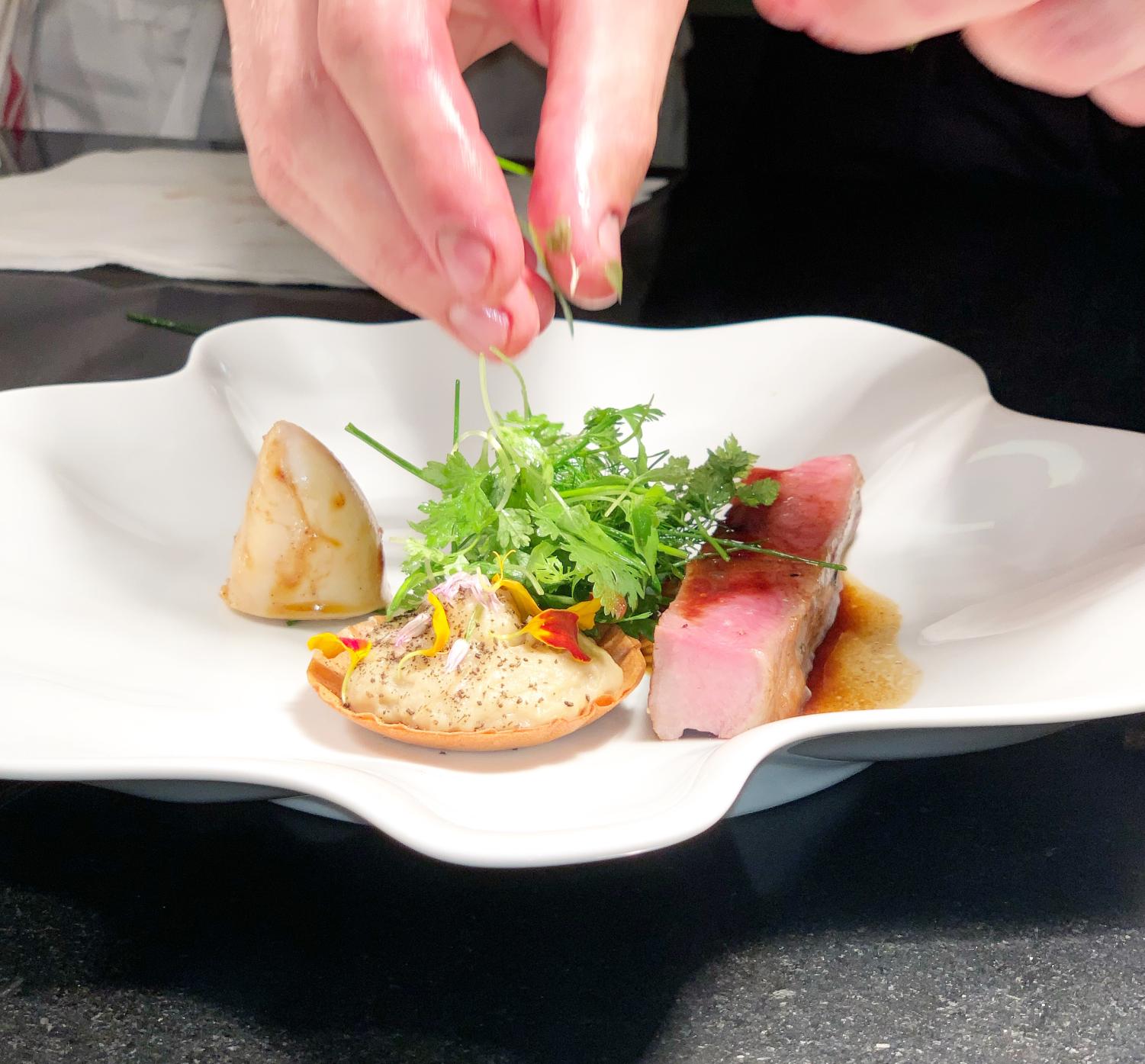
biology, texture, and timing to generate flavor highs. Want creaminess? That’s soaked cashews or blended avocado whipped with cold-pressed oils. Craving umami? Fermented nut paste with a dash of miso or smoked paprika might do it. Looking for something chewy? Enter dehydration — a slow, meditative process that transforms purees into crisps or vegetable leathers.
It’s not just food science — it’s neurogastronomy. The flavors, colors, crunches, and even smells are calibrated to trigger dopamine responses. Every bite is designed to make the brain think: “This is indulgence.” Some chefs even incorporate Indian superfoods like ashwagandha, tulsi, and triphala to elevate sensory depth while boosting holistic nutrition.
Once known solely for beach shacks and seafood thalis, Goa is quietly reinventing itself as a destination for mindful, luxury dining — and raw cuisine is at the heart of it. A growing tribe of chefs, wellness resorts, and boutique cafés are embracing the raw movement, blending Goan produce with modern gastronomy.
At wellness retreats like Bhakti Kutir in Palolem and Purple Valley Yoga in Assagao, raw meals are curated daily for international guests. These menus often feature seasonal fruits, coconut-based kefirs, probiotic smoothies, and raw chocolate desserts infused with local spices like cinnamon,
kokum, and cardamom.
In North Goa, cafés such as Greenr, Artjuna, and Earth Mama are turning heads with their raw breakfast bowls, activated nut cheeses, and sprouted grain wraps Even traditional Goan ingredients like kokum, jackfruit, and tambdi bhaji (red amaranth) are being reinterpreted in flame-free formats.
Chefs are collaborating with farmers in Canacona and Siolim to source pesticide-free greens, local moringa, and heritage tomatoes essential for maintaining the ingredient-first ethos of raw cuisine. With its laid-back rhythm and health-conscious clientele, Goa offers the perfect ecosystem for India’s raw food revolution to take root.
India, with its rich legacy of sattvic food and Ayurvedic wisdom, has long celebrated the power of uncooked ingredients. From raw banana salads in Kerala to Gujarat’s traditional “kacha kela nu shaak,” raw preparations are woven into the fabric of Indian culinary culture. But a new wave of chefs is taking this further — transforming raw Indian ingredients into high-end, plated art.
In Goa, Chef Shantanu Gupte has hosted immersive pop-up dining experiences showcasing dishes like dehydrated beetroot papdi chaat and coconut kefir panna cotta. Mumbai’s plant-based café scene, including eateries like Rare Earth Café and Earthlings, have introduced raw desserts like cashew cheesecakes and probiotic shots with turmeric and giloy.
Bangalore, a hub for health-conscious diners, has seen the emergence of raw food workshops, Ayurvedic fusion menus, and even raw-themed tasting events hosted in collaboration with yoga retreats and wellness resorts. These initiatives prove that India is not just adopting the global raw movement — it's enriching it with indigenous wisdom, spice profiles, and seasonal produce.
Raw fine dining may not replace fire-kissed cuisine, but it is rewriting the rules of luxury. In a world craving authenticity, sustainability, and connection, raw is not just relevant — it’s revolutionary.
Each uncooked plate is a celebration of nature, art, and restraint. Each flavor sings louder, not because of spice, but because nothing drowns it out.
No flames allowed. Just flavor, finesse, and fearless creativity.

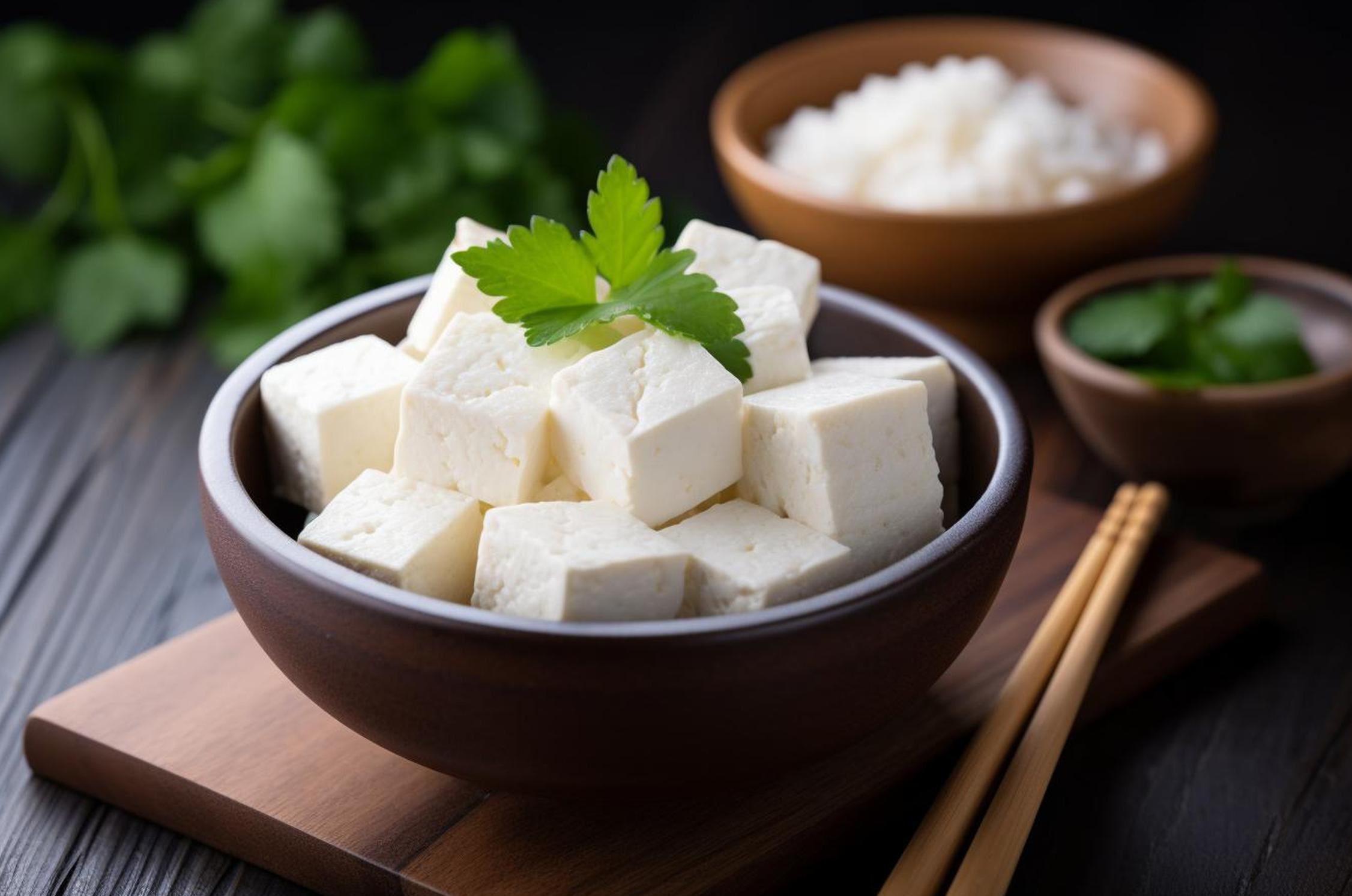
By Gauri Ghadge
It looks like paneer, tastes almost like paneer — but is it really paneer? From roadside stalls to upscale kitchens, the rise of fake, synthetic, or adulterated paneer is a culinary scandal hiding in plain sight. For millions of Indians who enjoy paneer as a proteinrich, vegetarian staple, this is more than just a quality concern — it’s a public health crisis. In this
deep dive, we explore what fake paneer is, how it's made, where it's found, how it harms your body, and what you can do to protect your plate.
Walk into any dhaba, fast food stall, or even a midrange restaurant and order a paneer dish — there’s

a good chance what you're served isn’t what you think. In 2022 alone, raids across major Indian cities including Mumbai, Delhi, and Lucknow uncovered several operations producing synthetic paneer using ingredients that had no business being in food. These included chalk powder, detergent, hydrogenated fats, and starches — all crafted to visually and texturally mimic authentic paneer. In a shocking case from Agra in 2023, nearly 1,500 liters of synthetic milk and 300 kg of fake paneer were confiscated by local authorities. The racket had been running for over three years, distributing to hotels and caterers in bulk. Disturbingly, lab analysis showed the samples contained no real dairy whatsoever — just a concoction of palm oil, caustic soda, and urea.
So what exactly is fake paneer? Also known as "analogue paneer " or "synthetic paneer, " this imitation is typically made by combining refined oils,
starch, citric acid, and food-grade chemicals to replicate the creamy texture and neutral taste of real paneer. Unlike authentic paneer, which is made by curdling milk with lemon juice or vinegar, fake paneer skips the dairy altogether or uses synthetic milk — a concoction made from detergent and white pigment.
The reason this fake version has proliferated is simple: cost. Where one kilogram of real paneer might cost 300–�400 to produce using fresh milk, its synthetic twin can be churned out for less than �120 per kilo. For small eateries working on thin margins and high competition, the incentive is enormous. And most consumers wouldn’t notice — at least not right away.
While the visual and taste mimicry of fake paneer might fool your senses, your body can’t be deceived for long. Nutritionists and doctors have been
sounding the alarm on the potential long-term effects of these substances, many of which are unregulated and toxic in large doses.
Dr. Deepa Malik, a gastroenterologist in Delhi, notes a surge in patients with unexplained digestive issues, bloating, and chronic acidity. “A common thread we find is their frequent consumption of lowcost paneer from eateries,” she says. Synthetic paneer often contains trans fats, which are linked to inflammation and cardiovascular disease. Additives like starch can spike blood sugar levels, while chalk and synthetic milk can lead to calcium imbalance, kidney stress, and even food poisoning.
In 2021, a consumer report by the Centre for Science and Environment (CSE) found that nearly 25% of paneer samples collected from local markets failed basic purity tests. Alarmingly, some contained detergent-like residues and soap-like foam when mixed with water.
If you're wondering whether that soft white cube in your curry is genuine or a clever imposter, you're not alone. With fake paneer becoming increasingly sophisticated in texture and appearance, the onus is on us — the consumers — to stay informed. Luckily, several easy, science-backed techniques can help you distinguish the real from the replica.
1. The Texture Test
What to do: Gently press the paneer between your fingers.
What to look for:
Real paneer will feel slightly grainy and moist. It breaks apart with light pressure and has a soft, sponge-like bounce.
Fake paneer, in contrast, feels rubbery, unusually firm, or unnaturally smooth — almost plastic-like in consistency. It may resist pressure or stretch slightly like processed cheese.
Pro Tip: Try slicing a cube with a knife. If it cuts unevenly or leaves a stringy edge, that's a red flag.
2. The Heat Test
What to do: Heat a small cube of paneer in a nonstick pan without oil.
What to look for:
Real paneer will release a little moisture and start to
soften or brown at the edges. It maintains its structure but becomes tender.
Fake paneer may shrink, harden, or release oil — a clear sign of adulteration with hydrogenated fats or synthetic binders.
Pro Tip: Watch out for bubbles or foam forming in the pan — this could signal detergent or synthetic emulsifiers.
3. The Iodine Starch Test
What to do: Take a small paneer sample, add a few drops of iodine tincture (available at any pharmacy).
What to look for:
If the surface turns blue, black, or purple, it means the sample contains starch — often used in fake paneer as a filler.
If there's no color change, the starch content is negligible or absent — a good sign.
Caution: Use a white plate and good lighting for accurate observation. This test is widely used even by food inspectors in field checks.
4. The Smell Test
What to do: Smell the raw paneer as soon as you unpack it.
What to look for:
Real paneer has a faint, fresh dairy scent — clean and slightly sour like curd.
Fake paneer may have no smell, a chemical odor, or — in worse cases — a faint plastic or detergent-like aroma.
Pro Tip: If it smells like nothing at all, it's still suspicious — because real dairy always has some aroma.
5. The Water Soak Test
What to do: Soak a small piece of paneer in warm water for 10–15 minutes.
What to look for:
Real paneer will become softer and creamier. The water may get slightly cloudy due to the release of milk solids.
Fake paneer often becomes tough, rubbery, or breaks apart unnaturally. The water may turn oily or develop foam if chemicals are present.
INDUSTRY INSIGHT: THE RESTAURANT DILEMMA
Many restaurant owners knowingly or unknowingly
use fake paneer due to unreliable suppliers or cost pressures. “The margins are brutal,” says Anil Rajput, owner of a North Indian restaurant in Pune. “We try to use the best ingredients, but when your neighbor is serving paneer dishes at half your price, customers compare only the cost — not the quality.” While high-end restaurants may source from reputable dairies, budget eateries and caterers often fall prey to bulk suppliers offering cheap, adulterated products. Some even re-freeze stale paneer or reuse paneer that has crossed expiration dates by washing it in hot water — another shady trick that deteriorates quality and safety.
The Food Safety and Standards Authority of India (FSSAI) mandates that all dairy products meet certain quality standards, including protein and fat content. It also requires non-dairy substitutes to be labeled as "analogue dairy products" — a guideline that is often flouted. Inspections are irregular, and fines for violators remain minimal, allowing offenders to operate with little fear. In response to growing concerns, FSSAI launched a nationwide campaign in 2023 urging state agencies to conduct surprise checks in local markets, but experts say this is not enough. “We need stricter enforcement, real-time lab testing, and consumer helplines to report suspicious food,” says food safety activist Gaurav Mishra.
India’s relationship with paneer runs deep. It’s not just a dish — it’s part of wedding feasts, temple offerings, and everyday thalis. The invasion of fake paneer is therefore not just a health issue; it's a betrayal of culinary heritage. When families unknowingly feed adulterated food to children and elders, the repercussions are generational — not just gastronomical.
Call to Action: What Can You Do?
Buy Local, Not Bulk: Choose trusted local dairies over mass-produced, branded packets that may lack transparency.
Ask Restaurants: Don’t hesitate to ask where their paneer is sourced from — it sends a signal that
customers care.
Educate Staff and Family: Share knowledge about detecting fake paneer with those who shop and cook at home.
Support Clean Labels: Push for transparency in food labelling, ingredient lists, and certification.
Report Violations: Use platforms like FSSAI’s Food Safety Connect App to report suspected adulteration anonymously.
In a country that prides itself on culinary tradition and spiritual purity, fake paneer is a shocking contradiction. It erodes trust, endangers health, and cheapens an ingredient that has fed generations. But it doesn’t have to continue. Awareness is the first step. By questioning what’s on our plate and demanding better, we can protect our food — and ourselves.
Next time you bite into a paneer tikka or savor a malai kofta, ask yourself: is this paneer... or pretend?
Bonus Tip: If you're unsure, try making paneer at home — it's easy, requires just two ingredients (milk and lemon juice), and ensures purity on your plate.
Note: All information is based on verified reports, government guidelines, media investigations, and data available as of April 30, 2025. For the most upto-date regulations, visit www.fssai.gov.in.



By Gauri Ghadge

Once synonymous with lazy beach vacations and year-end parties, Goa is now transforming quietly. A new breed of traveler — the digital nomad, remote worker, solopreneur, and startup founder is reshaping the state’s hospitality landscape. What started as a trickle during the pandemic has matured into a full-blown movement: the rise of hybrid hospitality.
Welcome to the era of Work, Stay, Eat a seamless integration of workspace, living quarters, wellness, a n d g o u r m e t d i n i n g i n t o o n e compelling lifestyle experience.
F R O M T O U R I S T S T O
As work-from-anywhere culture took root globally, Goa emerged as a top choice for professionals seeking a blend of productivity and peace. Its slower pace, tropical climate, scenic surroundings, and relative affordability made it a magnet for remote workers. What followed was the evolution of hospitality spaces from short-stay resorts to long-term, experience-led havens.
“We didn’t just want to rent a place. We wanted to belong somewhere,” says a UX designer from Bangalore who spent six months living and working at NomadGao. “It was the sense of
community, curated events, and freedom to work by the beach that changed everything.”
D E C O D I N G H Y B R I D HOSPITALITY: THE NEW MODEL
Hybrid hospitality blurs the lines between hotels, homes, hostels, and o f f i c e s T h e s e a r e n o t j u s t accommodations they are social ecosystems. A typical hybrid space in Goa offers:
F Private or shared rooms
F Co-working zones with highspeed internet
F Wellness offerings like yoga and meditation
F Communal kitchens and dining spaces
F Events, networking, and weekend explorations
F Flexible pricing models for weeklong or monthly stays
This model caters to a lifestyle, not just
Ÿ NomadGao (Assagao & Morjim) –Community-led work villages
Ÿ The Hosteller (Anjuna &Arpora) –Long-stay rooms with startup-friendly amenities
Ÿ Greenr Work Studios (Anjuna) – Plantbased café meets coworking space
Ÿ Funky Monkey (Arambol) – Creative long-stay retreats
Ÿ Artjuna (Vagator) –Iconic wellness café with event spaces
a stay, and Goa is at the forefront of this global shift.
1. NomadGao – Assagao & Morjim
Starting with Vaibhav Dabhade in 2020, NomadGao has become a beacon for digital nomads in Goa. With a focus on community-building, its Assagao campus offers a co-working village vibe, complete with networking events, curated guest speaker series, and mindfulness workshops.
N o m a d G a o h a s a t t r a c t e d professionals from over 30 countries and launched “Remote Explorers,” a curated long-term stay for global entrepreneurs.
2. The Hosteller, Anjuna & Arpora
Known for its backpacker vibe, The Hosteller has shifted gears in Goa. It now offers long-stay plans for creators and startup teams With ergonomic workspaces, power backup, and a food menu designed for productivity (think smoothies, bowls, and cold brews), it appeals to the modern “workcation” crowd.
3. Greenr Café & Work Studios, Anjuna
Started as a plant-based café, Greenr has evolved into a creative ecosystem. With wellness-focused menus, flexible co-working, and curated experiences like design pop-ups and acoustic

evenings, it caters to a tribe of slowliving professionals.
productivity without pressure
F Affordable land and infrastructure (compared to metros)
Ÿ Fast Wi-Fi (100 Mbps+)
Ÿ Ergonomic workspaces
Ÿ Plant-forward menus
Ÿ Weekly events & workshops
Ÿ Community kitchens
Ÿ Flexible bookings by week/month WHAT TODAY'S GUESTS EXPECT
An offbeat, artsy retreat turned hybrid hub, Funky Monkey offers long-stay c a b i n s , a c o m m u n a l k i t c h e n , performance spaces, and a reliable 100 Mbps connection. Their “Work & Play” program has drawn musicians, coders, healers, and freelancers from across Europe.
Several factors make Goa the perfect petri dish for hybrid hospitality:
F A relaxed lifestyle that supports
F A global expat and backpacker community that supports cultural exchange
F Well-connected locations with proximity to beaches, cafes, and coworking hubs
F A growing ecosystem of tech, w e l l n e s s , a n d c r e a t i v e professionals
Moreover, the local hospitality industry has shown an impressive ability to adapt traditional hotels are converting wings into coworkingfriendly zones, and homestays are

upgrading Wi-Fi and interiors to suit remote workers.
It’s no longer about just amenities — it’s about alignment with lifestyle values:
Sustainability: Composting, local produce, eco-built accommodations
Health-conscious food: Vegan, gluten-free, Ayurvedic, organic
Mindfulness experiences: Morning yoga, guided journaling, nature walks
Community: Dinners, open mic nights, coding marathons, language exchange Flexibility: Check-ins by the week, no lock-ins, scalable rooms
This mindset has created a new kind of loyalty — not through reward points but through emotional resonance.
The Business Angle: Why Hospitality
Hybrid hospitality isn’t just a passing trend it’s a shift in consumption behavior. Here’s why it matters:
Higher Occupancy: Longer stays mean more stable bookings and predictable revenue.
Better Word-of-Mouth: Digital nomads and content creators organically share their stays.
Cross-Selling Potential: Add-on revenue from coworking, F&B, excursions, and events.
Brand Value: Being known as a “remote work-friendly” property gives massive marketing leverage.
Despite the boom, operators face hurdles:
Licensing: Zoning laws don’t always
Ÿ 65% of long-stay guests in Goa now book accommodations with co-working access
Ÿ 4 out of 5 hybrid hubs in Goa include sustainability as a brand pillar
Ÿ 45% of boutique hotels report higher retention with flexible long-stay packages


accommodate hybrid models.
Internet Reliability: Power outages and poor connectivity in some areas remain issues.
Seasonal Slowdowns: Monsoons still reduce footfall for offbeat long-stays.
Community Burnout: Managing events and guest expectations over long periods can exhaust small teams.
To overcome this, many brands are collaborating — forming remote work circuits, co-branding with tech firms, a n d i n v e s t i n g i n l o n g - t e r m infrastructure.
LOOKING AHEAD: IS GOA THE NEXT BALI?
Goa shares much in common with digital nomad havens like Bali and Chiang Mai tropical climate,
affordability, strong community, and a relaxed cultural backdrop. But what sets Goa apart is its cultural blend, its openness, and its evolving hospitality DNA.
New players are entering the market — boutique developers, coworking brands, and international investment groups are eyeing Goa as the next big workcation hub.
Meanwhile, the Government of Goa has initiated dialogue around positioning the state as a “Remote Work Tourism Destination,” with policies that could support digital nomads through extended visas, local SIM access, and formal co-living permits.
As the lines between life and work blur, so do the boundaries between hospitality and lifestyle. Goa, once a
dreamy escape, is now a strategic destination for people who want to live meaningfully, work mindfully, and eat beautifully.
In the age of hybrid everything, Goa’s hospitality sector isn’t just adapting — it’s innovating.
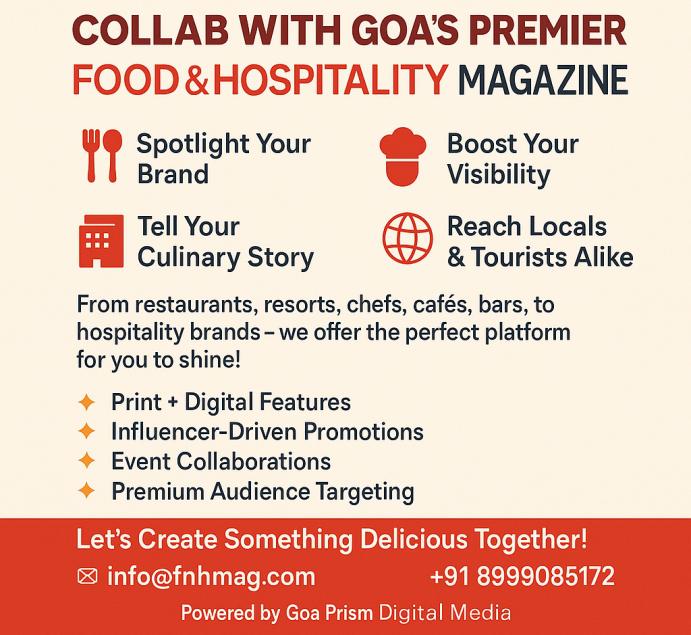


By Aditi Malhotra
While Thailand may have made mango sticky rice iconic, this tropical dessert takes on a whole new vibe with a Goan twist. By combining fresh Alphonso mangoes, creamy coconut milk, and an aromatic ginger-lime drizzle, this summer dish is both refreshing and indulgent. It’s light, naturally sweet, and ideal for lazy summer afternoons or fuss-free entertaining.
For the sticky rice:
1 1/2 cup glutinous rice (or short grain rice)
1/2 cups coconut milk
1/4�cup sugar (adjust based on sweetness of mangoes)
A pinch of salt
For the ginger-lime drizzle:
1 tbsp grated fresh ginger
2 tbsp honey or palm jaggery syrup
Juice of 1 lime
Zest of half a lime
To serve:
1-2 ripe Alphonso mangoes, peeled and sliced
Toasted sesame seeds or shredded coconut (optional garnish) Mint leaves (optional)
Method
F Soak the rice in water for at least 2–3 hours, or overnight if possible.
F Steam the soaked rice in a bamboo or metal steamer for 20–25 minutes until soft and translucent.
F In a saucepan, warm the coconut milk, sugar, and salt—don’t boil. Pour this mixture over the cooked rice and let it sit, covered, for 15 minutes so the rice soaks in all the flavor.
F Mix the ginger, lime juice, zest, and honey for a refreshing drizzle.
F Assemble: Scoop sticky rice onto a plate, layer it with fresh mango slices, and spoon over the ginger-lime drizzle. Garnish with toasted sesame or shredded coconut, and mint leaves if desired.
F Serve chilled or at room temperature.

By Aditi Malhotra
This lighter take on grilled chicken combines cooling Indian spices like fennel and mint with the creamy tang of buttermilk to create juicy, flavorful skewers that are perfect for summer grills, beach picnics, or garden brunches.
INGREDIENTS
500 g boneless chicken (thighs or breast), cut into medium cubes
1 cup buttermilk
1 tbsp fennel seeds, roasted and crushed
2 tbsp fresh mint leaves, finely chopped
1 tsp cumin powder
1 tsp coriander powder
1 tsp ginger-garlic paste
1 green chilli, finely chopped (optional)
Juice of half a lime
Salt to taste
Skewers (wooden or metal)
F Whisk together the buttermilk, spices, mint, chilli, ginger-garlic paste, lime juice, and salt in a bowl.
F Add chicken pieces and coat well. Marinate for at least 3–4 hours, ideally overnight in the fridge.
F Thread marinated chicken pieces onto skewers.
F Grill on a hot pan or BBQ, basting with leftover marinade, until golden and cooked through (about 10–12 minutes).
F Serve hot with cooling mint chutney, cucumber raita, or a simple salad.

By Armaan Malhotra
There’s a quiet revolution happening in the Indian food scene—not on TV shows or five-star menus, but in intimate gatherings, weekend pop-ups, and chef-led home-style feasts that take you straight back to your roots. These aren’t your typical restaurant events or buffet spreads. These are personal, often invitation-only experiences, where regional Indian cuisine takes center stage—not just the butter chickens and biryanis of the world, but the forgotten recipes, the
community dishes, the "ghar ka khaana" that once stayed tucked away in our grandmothers’ kitchens.
From Konkani Saraswat thalis in Goa to Naga smoked pork pop-ups in Mumbai, and Bihari or Kodava meals served in intimate home settings in Delhi or Bangalore, food lovers are leaning into their heritage—and they’re inviting the rest of the country to join the table.
THE SHIFT FROM RESTAURANT TO EXPERIENCE

For years, fine-dining in India was dominated by global cuisines or overly stylised versions of North Indian classics. But diners today are no longer just looking for good food—they want a story, an experience, a memory on a plate.
Enter: the regional cuisine pop-up often hosted by passionate home cooks, community chefs, or professionals who’ve taken off the chef coat to return to their roots. These events are deeply personal. The food served often comes from family recipes passed down through generations, each dish carrying the weight of memory, celebration, and community. These meals are sometimes set in heritage homes, private gardens, or boutique venues, where menus are built around a single cuisine, region, or even festival. It’s not uncommon to be told about the origins of a particular chutney, the ritual around a festive dish, or how a masala is stone-ground just like it was 70 years ago.
What makes these pop-ups special is their emotional depth. For many chefs and cooks, these experiences are about reclaiming their identity—bringing back dishes that were either too humble for restaurant menus or too complicated for
commercial kitchens.
Think of Telangana’s gongura mutton, Assam’s xaak bhaji, Mangalorean sukkas, Pahadi-style bhatt ki dal, or Goan Patal bhaji. These are dishes loaded with history, eaten in family homes during festivals or everyday meals—not something you’d usually find when dining out.
Even within the same state, hyper-regionality is being celebrated. A Bengali pop-up may focus on Chitrita (ancestral East Bengal) cuisine, while a Kerala experience may explore the Christian Syrian culinary traditions rather than the usual sadhya.
There’s a growing fatigue with food that’s overly Westernised, overly styled, and sometimes stripped of context. In a world that’s increasingly fast, people are hungry for comfort, authenticity, and connection things that home-cooked, regional food offers in abundance.
The pandemic also played a role. As restaurants shut down, many turned to their kitchens and rediscovered their roots. What started as cooking for comfort turned into curated dining experiences, where small groups could enjoy safe,

immersive meals rooted in heritage.
Also, as food becomes more inclusive, there’s pride in representation. Regional cuisine pop-ups allow communities to tell their own stories, on their own terms. Whether it's a Bohri daawat, a Kodava harvest feast, or a Jain thali with no onion or garlic—there’s power in reclaiming these narratives.
Goa, with its multicultural identity and deep food heritage, is becoming a growing part of this pop-up wave. From Saraswat Brahmin thalis to Catholic feasts with tongue roast and caldine, regional Goan cuisine is finding new platforms—and a renewed audience.
Chefs and food curators are going beyond the beach shack stereotype and exploring Gaud Saraswat dishes, traditional Hindu vegetarian fare, and forgotten Portuguese-influenced sweets. These pop-ups often include storytelling, local ingredients, and even Feni or urak pairings that tie into the Goan identity.
In fact, Goa’s laid-back energy, strong sense of community, and abundance of local produce make it the perfect host for intimate, curated dining experiences that celebrate not just food, but culture.
T H E WAY F O R WA R D : F R O M P O P - U P S T O
What started as a trend has become a movement. These popups aren’t just about celebrating food they’re about preserving it. Every meal shared, every story told, helps document and safeguard culinary traditions that might otherwise be lost.
There’s also a quiet rebellion in this return to the roots—a pushback against uniform menus and watered-down dishes. It’s an assertion that your food, your region, your story matters. And that celebration doesn’t always need champagne and caviar—it can begin with a ladle of kadhi or a spoonful of payasam served with pride.
In a time when the world feels more disconnected than ever, food has become a way to reclaim joy and belonging. These regional cuisine pop-ups are not just meals they’re conversations, histories, and invitations to share something real.
So the next time you see a humble handwritten invite for a pop-up thali, or a post about a one-night-only Assamese feast—go. Sit down, listen, eat. Because somewhere between the first bite and the last story, you just might find your own connection to home.
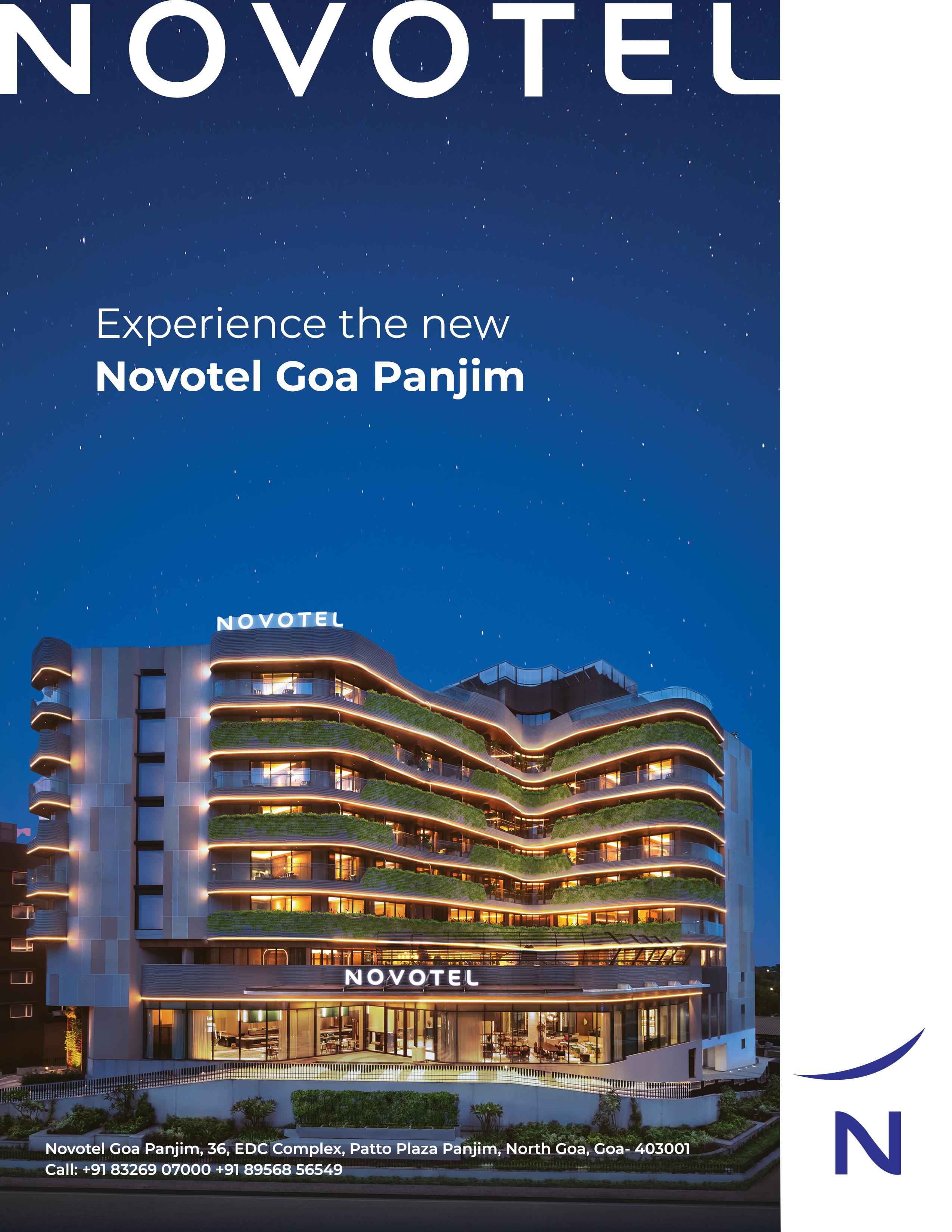


By Gauri Ghadge
Hotels are no longer built just for guests — they’re built for the lens. Welcome to the era where design is dictated by shareability, and every pillow, plate, and poolside is curated for the 'gram.
THE SOCIAL MEDIA INFLUENCE ON HOSPITALITY DESIGN
In an era where social media dictates travel trends, the
hospitality industry is undergoing a seismic shift. Hotels and resorts are no longer just sanctuaries for rest — they’ve become interactive film sets, designed not for solitude but for scrolls. The design of these spaces is increasingly influenced by the desire to create visually captivating environments that guests are eager to share online.
A study published in the Journal of Tourism and Hospitality found that over 40% of millennial travelers prioritize


"Instagrammability" when choosing a destination. That statistic alone has rewritten the blueprint for hotel design — form now follows filter.
Design elements like bold color palettes, geometric symmetry, mood lighting, and locally inspired architectural quirks have become non-negotiables. Aesthetic design is no longer an accent — it's the experience itself.
Creating an Instagrammable hotel space involves far more than throwing in a velvet couch or neon signage. It’s a nuanced art — the marriage of interior architecture, storytelling, and photographic logic.
Designers now collaborate with social media consultants during the build phase. Elements like natural lighting, reflective surfaces, textured backgrounds, and wide open corridors aren’t just good design — they’re algorithm-friendly. Every corner must tell a story, and every hallway must invite a scroll-stopping snap.
Features such as hanging rattan chairs, floating breakfasts, infinity bathtubs, or tropical-tiled walls are all part of a growing visual vocabulary. Importantly, hotels also lean into localized narratives incorporating region-specific art, cultural cues, and vernacular aesthetics to offer both originality and authenticity in an oversaturated digital feed.
To understand the rise of this trend, we must revisit the trajectory of hotel design itself. Once a functional box with a
bed and bath, hotels evolved during the 20th century into palaces of opulence and comfort.
Then came the boutique hotel movement — smaller properties with strong themes and identity — which laid the foundation for the visual revolution we see today. Now, with every guest wielding a 12-megapixel camera in their pocket and social media as a publishing platform, hotels have become stage sets for self-expression.
From custom murals to curated lighting and artisan ceramics, every detail is engineered to deliver that one moment: a guest, mid-stay, pausing to post.
What makes a room “Instagrammable”? It’s more than design — it’s emotional resonance. The psychology behind visual desire tells us that people respond to color contrast, symmetry, soft textures, and sensory minimalism. Social media has weaponized these human instincts into a new design language.
Guests aren’t just looking for beauty — they’re looking for social capital. One perfect frame from a visually striking corner becomes a passport stamp of identity: “I was here. I belong here.”
And when travel becomes a performance, hotels become the stage, props, and lighting crew.
The Education of Hospitality: Aesthetic Literacy Takes Center Stage
This shift has also filtered into hospitality education. Today’s hotel management courses are not limited to F&B service or

front desk training. Design schools now offer modules on mobile-first visual marketing, aesthetic branding, and guestcentered narrative creation.
Aspiring hoteliers are taught how design affects online engagement, and how seemingly small touches — a mirror placement, a bold-hued wall, or the way food is plated — can significantly impact guest perception and online amplification.
What was once a job about comfort and cleanliness is now also about curation and choreography.
Let’s talk numbers. Instagrammable design isn't just a branding
boost — it's a direct revenue driver. According to a report by Skift, usergenerated content showcasing specific hotels has been linked to a 15–20% increase in bookings, especially among millennial and Gen Z travelers. Reviews with photos consistently outperform those without, and many guests report being inspired to book a property purely because they saw it online.
Even more telling: influencers now partner with hotels not for money alone, but for backdrops. A space that gets posted by 100 microinfluencers in one weekend can outshine a �5 lakh ad campaign. For many properties, aesthetic virality is the most cost-effective marketing strategy available.
Yet not all that glitters is gold. As more hotels chase digital clout, some fall into the trap of gimmickry — designing for short-term social sizzle at the cost of comfort and long-term loyalty Overdesigned rooms with impractical layouts, or lobbies that feel more like showrooms than sanctuaries, can alienate guests looking for rest.
And for travelers, the social media pressure can erode the joy of discovery. When every meal must be photographed, and every corner must be styled for content, the vacation begins to feel like a job. What was once serendipitous becomes staged.
Hospitality must tread carefully. Design should serve the guest — not the algorithm.
Today, the most aspirational thing a hotel can offer isn’t gold faucets or marble staircases — it’s a story worth sharing. The new luxury is visual, emotional, and moment-driven. Instagrammable hospitality isn’t a passing trend — it’s a paradigm shift. The hotels that will thrive are those that offer more than just beautiful spaces. They will offer meaning, memories, and modern-day theatre. The frame is the hook, but the experience is what keeps guests coming back. Because in 2025, the traveler isn’t just checking in — they’re logging on.
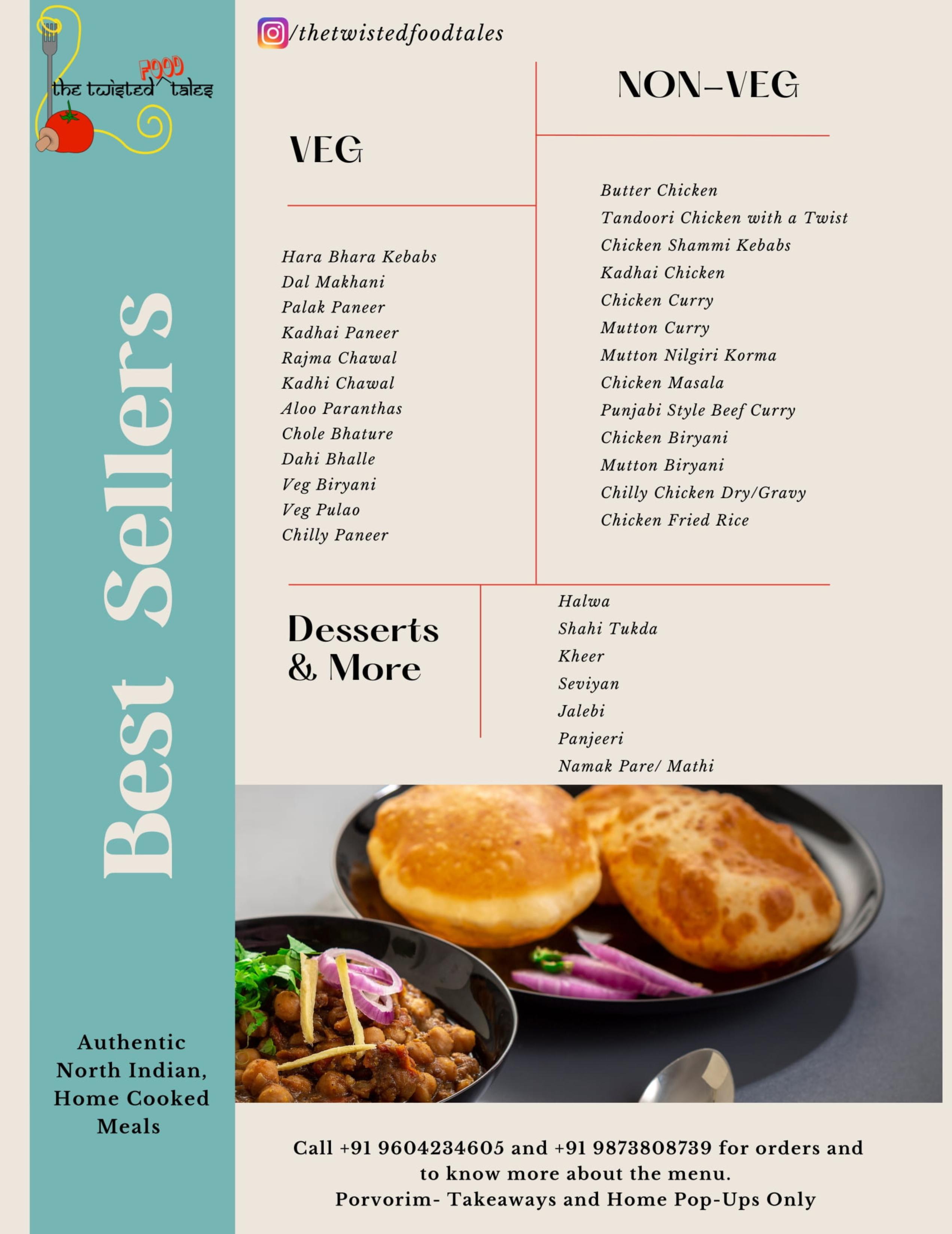
By Aditi Malhotra


There’s a reason why, at a celebration, the bar is often where the magic happens. It’s not just about the alcohol—it’s about anticipation, excitement, a little mystery, and that first sip that kicks the night off with promise. And in recent years, the cocktail world has taken its cue from the theatre—because let’s face it, people don’t just want drinks anymore, they want a show.
Welcome to the era of theatrical cocktails—a space where smoke swirls out of glasses, edible glitter dances in the light, spices infuse drinks tableside, and garnishes become edible sculptures. In a postpandemic world where every gathering feels a little more precious, cocktails have become more than
drinks. They’re conversation starters, mood-setters, and the c e n t r e p i e c e o f m a n y a celebration.
In the world of modern mixology, it's no longer enough for a drink to taste good—it has to look stunning, smell intriguing, and create a moment. Theatrical cocktails are all about this multi-sensory experience.
Take the classic Old Fashioned. With the simple addition of a cloche filled with wood smoke, what was once a broody, slowsipping drink transforms into a performance. You watch the bartender light the wood, trap the smoke, and release it just as the drink hits your table. The smoky aroma hits you before the whiskey ever does, priming your senses for what’s to come.
Similarly, using dry ice, infused fog, or bubbling overflows adds a surreal, almost cinematic flair.
B a r t e n d e r s a r e n o w p a r t m i x o l o g i s t , p a r t magician crafting drinks that command attention and invite curiosity.
What was once reserved for food is now dramatically entering the bar. From infused syrups made of star anise and cardamom to rim salt spiked with chilli-lime zest, spices are no longer background players—they’re front and centre in today’s cocktails. This trend draws heavily from Indian flavors. Goa especially has become a playground for spiceforward cocktails, where everything from kokum to clove and cinnamon is being used creatively. Drinks like a "Masala Martini" or "Feni-spiked Tamarind
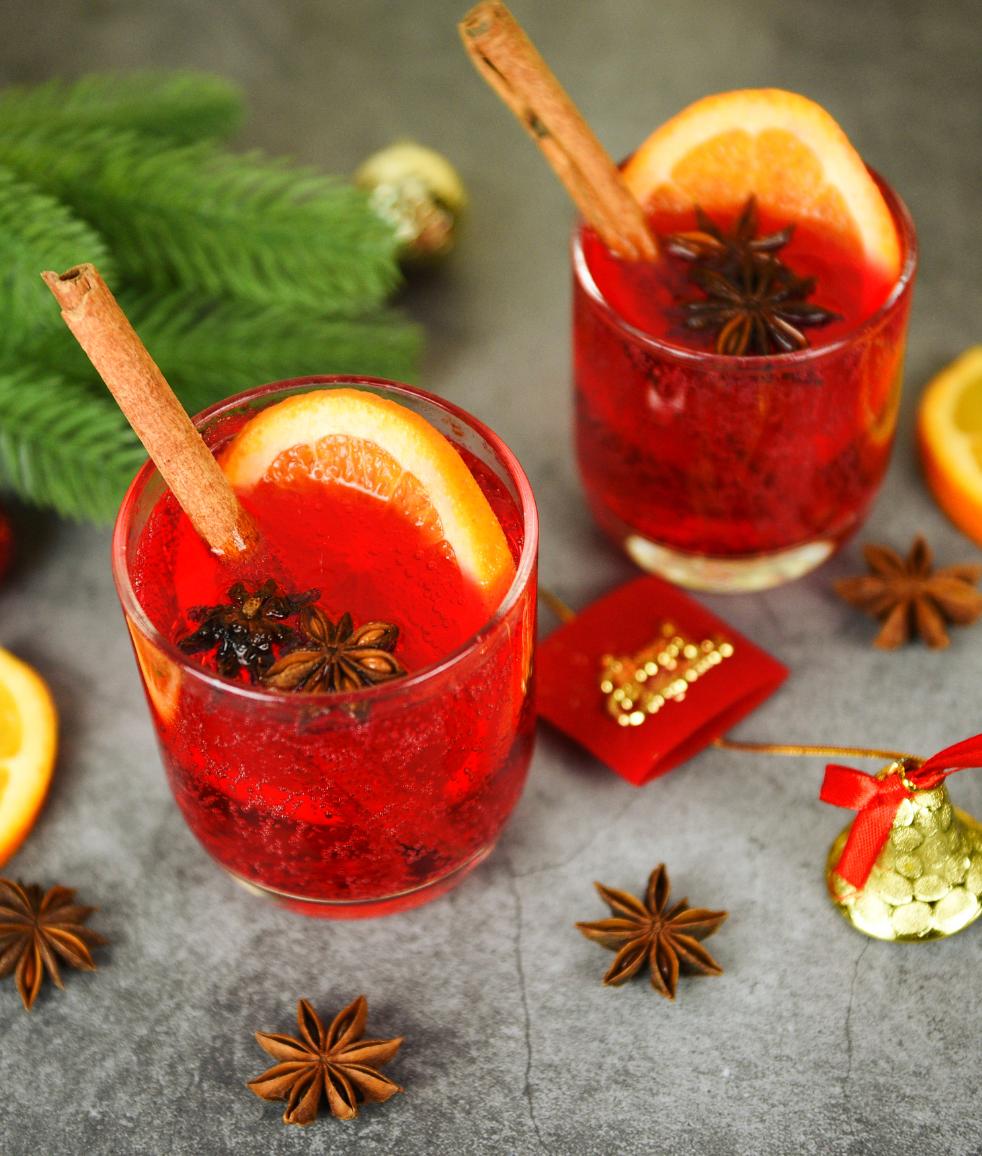
Sour" not only reflect local ingredients but also bring nostalgia and identity into every sip. Bartenders are also increasingly using fatwashing a technique that infuses spirits with flavoured oils or ghee to create depth and richness. Think a ghee-washed whisky with hints of cardamom and saffron for a decadent, festive drink that feels like Diwali in a glass.
The experience doesn’t stop at what’s in the glass—it extends to how the glass is presented, what’s on the rim, and even what music might be playing in the background Oversized goblets, vintage teacups, tiki mugs, and even smoking chalices have all found their place behind the bar.
Then there are the garnishes. No longer limited to an orange twist or maraschino cherry, today’s garnishes can be flaming citrus peels, gold-dusted rose petals, charred cinnamon sticks, or even microgreens frozen into edible ice c u b e s . T h e s e a r e n ’ t j u s t decorative—they change how you smell, sip, and savour the drink. It’s not uncommon now for a mixologist to torch an ingredient tableside or spritz a citrus mist right before serving. The idea is to involve the drinker—to make them feel like part of the act.
Goa, with its vibrant bar culture, beachside celebrations, and experimental energy, is the perfect stage for this cocktail theatre. Whether it’s a wedding sundowner, a birthday beach bash, or just a Tuesday night that calls for celebration, the Goan crowd appreciates flair—so long as it’s backed by flavour.
Local bartenders are increasingly embracing this style, marrying local spirits like feni and urak with international techniques, global bitters, and indigenous botanicals. The result? Drinks that celebrate where you are, who you’re with, and the joy of the moment.
So, the next time you’re out celebrating, don’t just order your usual. Ask what’s new. Look for the drink with the smoke trail, the edible flower, the hint of toasted spice on the rim Because theatrical cocktails aren’t just about showing off they’re about creating a story you’ll remember long after the glass is empty.
Here’s to drinks that surprise you. Stir you. And maybe, just maybe, steal the show.







Beneath the warm Goan sun, where the Arabian Sea gently kisses the shores of Benaulim, a different kind of magic is unfolding. At Fairfield by Marriott Goa Benaulim, the air is thick with the sweet fragrance of Champa, but it's not just the blossoms that are captivating hearts It's 'Stotrees' – a charming initiative that has transformed the hotel's lobby into a living tapestry of stories.
The venerable Champa trees traditionally stand as silent sentinels, with their knotted branches reaching out like welcoming arms. But at Fairfield Benaulim, they've been given a voice. Inspired by the idea of a Wish Tree, the team decided to breathe life into these trees, turning them into what they call
The Stotrees, meaning 'every leaf has a story.'
Guests are invited to pen their experiences, their dreams, their
little moments of joy on delicate paper notes, and then gently tie them to the Champa branches. Each note, a tiny leaf of its own, carries a unique tale – a whispered wish for a sundrenched day, a heartfelt thank you to a smiling staff member, a memory of a perfect sunset.
As you walk beneath the 'Stotrees,' you're enveloped in a chorus of emotions. The rustling leaves carry the echoes of laughter, the silent hopes of travelers, and the shared joy of a memorable Goan holiday. It's a testament to the power of storytelling, a reminder that even the simplest of things can hold profound meaning.
The 'Stotrees' campaign is more than just a decorative touch, it's a celebration of connection, a way to weave the stories of guests into the very fabric of the Fairfield experience. It's a
gentle invitation to slow down, to appreciate the beauty of the moment, and to leave a piece of yourself behind, blooming alongside the fragrant Champa. In Benaulim, every leaf truly does have a story, and Fairfield is creating a beautiful garden of them.
On March 8, Fairfield by Marriott Goa Benaulim held a touching event to celebrate its female team members. Led by the General Manager and department heads, the gathering combined heartfelt surprises with lively camaraderie that left everyone beaming with smiles.
The celebration kicked off with a welcoming gesture that set

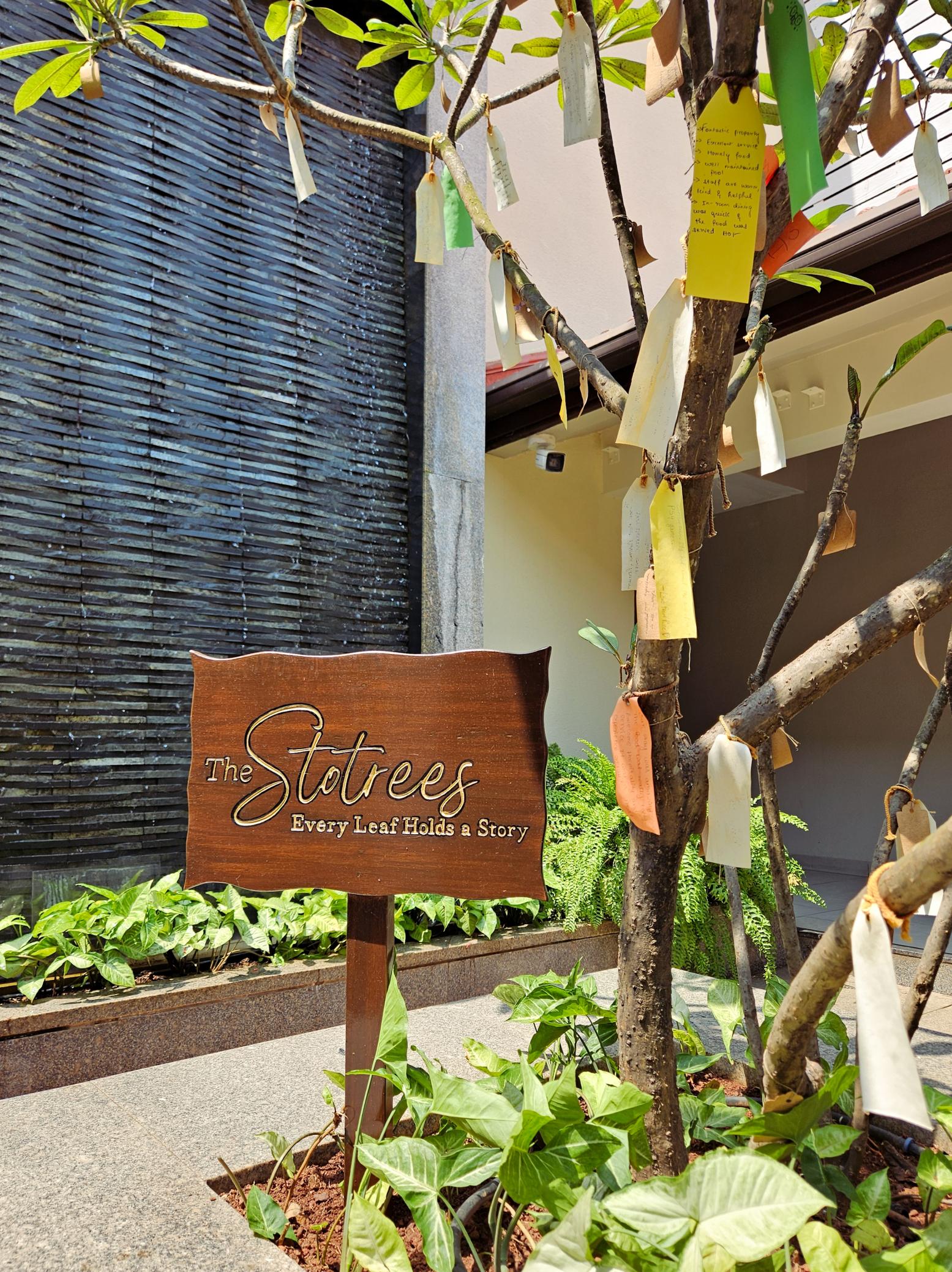
the tone, a refreshing mocktail paired with a delicate rose greeted every woman upon arrival. This thoughtful start was quickly followed by an atmosphere charged with emotions as the women came across a massive message board decorated with personal notes, each conveying heartfelt appreciation and respect from their colleagues.
In addition to this, the photo booths and meticulously arranged decor, organized by the men of the property, formed a visual tapestry of admiration and unity, a place to allow women to be themselves and pause for memorable snapshots. The festivities took an engaging turn with a series of interactive games, each carefully planned by a different team member. Laughter and spirited competition sparked the air as everyone dove into the activities, strengthening bonds with a
touch of anticipation. Adding to the joyful ambiance was a delightful potluck feast, where the culinary talents of the men shone brightly. Their lovingly prepared dishes not only satisfied appetites but also served as a delicious reminder of the close-knit teamwork within the resort. It was inspiring to witness such genuine efforts of care and celebration. The event underscored that Fairfield by Marriott Goa Benaulim is more than a workplace. It's a family that honors every member with heartfelt gestures a n d a n u n w a v e r i n g s e n s e o f togetherness.
Tucked away within the charming Fairfield by Marriott Goa Benaulim, a hidden gem exists: the resort's acclaimed spa. It's more than just a place for relaxation; it's a carefully crafted sanctuary where age-old traditions meet modern spa therapies, earning it rave reviews and setting a new standard for resort wellness. The spa's charm is found in its ability to whisk guests away from a bustling environment to a world of Susegado. Its design, seamlessly blending with the natural surroundings, fosters an immediate sense of calm. But the true magic lies in its innovative therapies curated by the spa connoisseurs. Utilizing a blend of traditional e l e m e n t a l p r i n c i p l e s a n d contemporary techniques, the spa offers treatments that go beyond surface-level relaxation. From specialized massages targeting deep muscle tension to revitalizing facials incorporating natural skincare products, each therapy is set to deliver tangible results.
Beyond the buzz, the consistent praise stems from a holistic approach Staffed by highly trained therapists, the spa prioritizes personalized experiences, tailoring treatments to individual needs. This dedication to excellence, coupled with the spa's commitment to using high-quality products, creates an experience that resonates with guests long after they leave.
The spa at Fairfield by Marriott Goa Benaulim isn't just a luxury, it's an integral part of the resort's commitment to holistic wellbeing. It's a testament to the power of thoughtful design and genuine care, redefining what a resort spa can achieve.


By Sunil Malhotra

When summer arrives in full swing—especially in tropical coastal belts like Goa—your body knows before your calendar does. You wake up thirstier, your appetite shifts, and your cravings subtly start leaning toward lighter, hydrating, and more refreshing meals. That’s no coincidence—it’s your body’s way of saying: "Cool it down."
In Indian food culture, seasonal eating isn’t a trend—it’s tradition. Our grandmothers may not have known the scientific jargon, but they instinctively fed us what the body needed most during hot months. From cooling herbs and water-rich fruits to fermented drinks and light grains, summer’s bounty is nature’s antidote to the rising mercury.
This article explores the foods that keep your body cool, why they work, and how to naturally align your diet with the season—without sacrificing flavor or satisfaction.
Summer heat puts stress on the body. You lose fluids and electrolytes through sweat, your digestive system slows down, and you may even experience inflammation, acidity, or fatigue. Cooling foods don’t just hydrate—they also help regulate internal temperature, reduce heat-related inflammation, and support digestion.
Ayurveda refers to this as balancing your Pitta dosha, which governs metabolism and tends to spike in hot weather. By choosing foods that pacify this heat, you support not just physical wellness, but mental clarity, skin health, and overall energy levels.
Let’s dive into the best foods to load your summer plate with—and why they work.
1. Cucumber
Rich in water, vitamin K, and silica, cucumbers are practically made for summer. They hydrate, soothe the digestive tract, and help flush toxins from the body. Snack on them raw, blend into smoothies, or mix with yogurt for an instant cooling raita.
2. Kokum
A Goan staple and a hidden summer superfood, kokum is a natural coolant with digestive and anti-inflammatory properties. Often consumed as sol kadhi or kokum sherbet, it’s particularly effective after heavy meals to relieve acidity and heat-induced bloating.
3. Buttermilk (Chaas)
A post-meal buttermilk isn’t just a tradition—it’s a science-
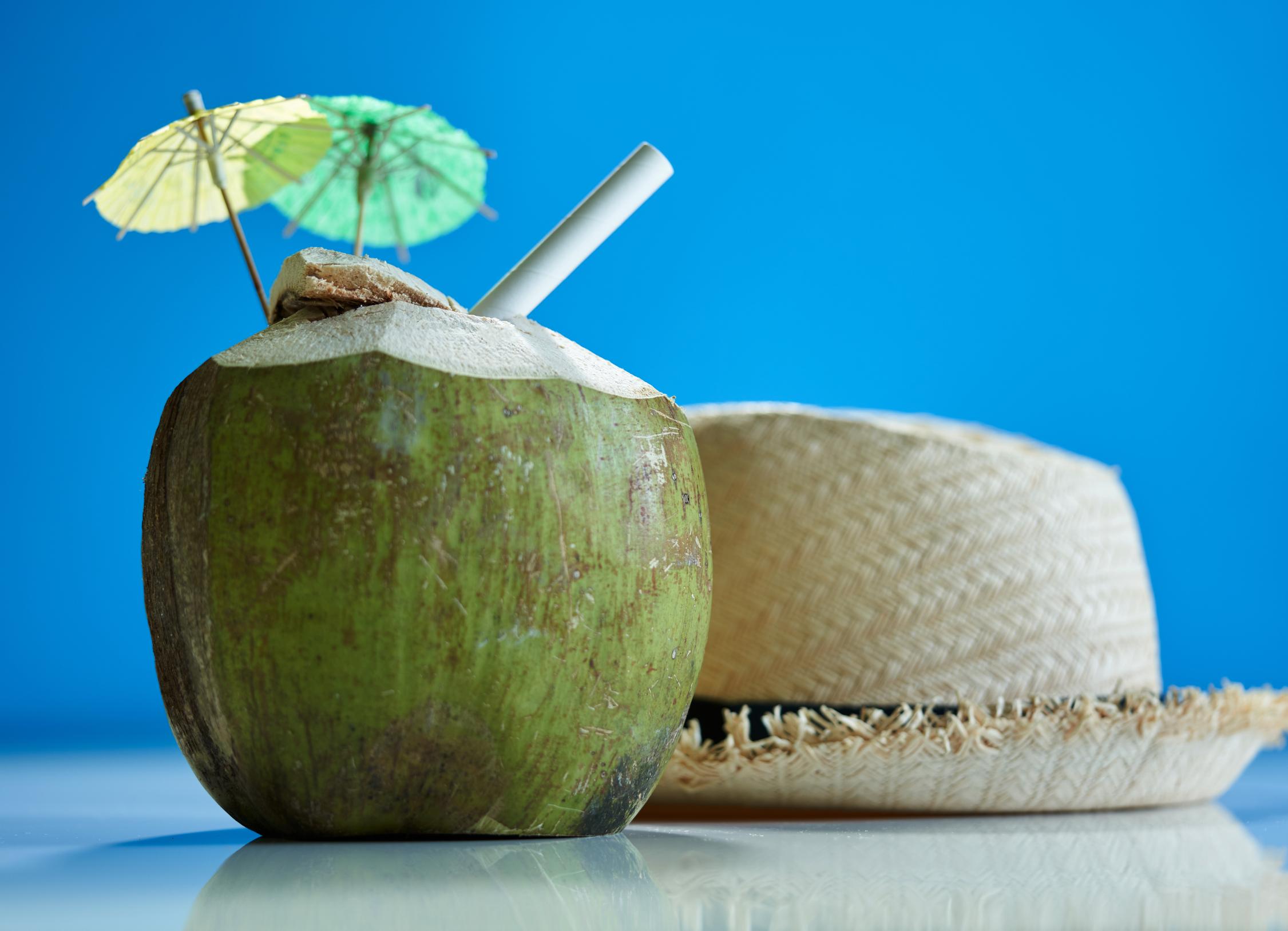

backed digestive. The combination of probiotics, spices like cumin and ginger, and cooling dairy makes it perfect for balancing gut heat.
4. Watermelon & Musk Melon
High in water and natural sugars, melons are hydrating, mildly diuretic, and rich in antioxidants like lycopene. Add them to salads, freeze into popsicles, or juice them with a hint of lime and mint for a refreshing drink.
5. Fennel Seeds (Saunf)
Soaked overnight and consumed as a morning drink, fennel seeds are known to reduce body heat and improve digestion. They also freshen breath and ease indigestion—a double win for post-summer-feast relief.
6. Tender Coconut Water
An all-time favorite, coconut water is loaded with electrolytes, potassium, and natural sugars. It cools the system, prevents dehydration, and restores minerals lost through sweating.
7. Mint & Coriander
Herbs like mint and coriander not only add flavor but also have natural cooling effects. Add them to chutneys, sprinkle over salads, or infuse in drinking water for a subtle, refreshing twist.
8. Sabja Seeds (Basil Seeds)
Soaked sabja seeds swell up and form a jelly-like texture. Known for their ability to cool the body from within, they are great in faloodas, lemonades, or fruit drinks. They’re also rich in fiber, which aids digestion and satiety.
9. Lauki (Bottle Gourd)
Though often dismissed, lauki is one of the most hydrating and cooling vegetables. Light on the stomach, it can be made into soups, curries, or even juice (when combined with mint and lemon) for a detoxifying effect.
Equally important is knowing what to skip or reduce during peak summer: Spicy, fried foods: These generate internal heat and may cause acidity. Heavy meats and rich gravies: Difficult to digest when the body is already in overdrive.
Caffeinated and sugary drinks: They may dehydrate you, even if they feel refreshing short-term.
Alcohol: It’s dehydrating, especially when consumed during the day in high heat.
Instead, opt for lighter cooking methods—steaming, sautéing, or raw preparations and keep your meals smaller but more frequent.
Eat your heaviest meal at lunch, when digestion is strongest. Drink plenty of water, but sip it slowly throughout the day. Avoid skipping meals, even if appetite dips—just eat light and fresh.
Stay in shade and avoid strenuous workouts during peak afternoon heat.
Eating with the season is not about restriction—it’s about rhythm. Listening to your body, embracing what nature offers, and adjusting your habits accordingly. Summer brings its own joys, and with the right foods on your plate, it can be as delicious as it is rejuvenating.
So whether you're sipping kokum under a palm tree or relishing a bowl of chilled cucumber soup at home, remember—what you eat can be your greatest tool to stay cool.


By Sunil Malhotra

If you’ve been even remotely interested in health over the past few years, you’ve definitely heard someone say, “Oh, I’m on IF now.” Intermittent Fasting, or IF, has swept through wellness circles like wildfire—touted as a miracle fix for weight loss, better digestion, hormonal balance, and even longevity. But amid all the Instagram transformations and overnight success stories, the question remains: Is intermittent fasting just another health fad, or does it truly offer functional, long-term benefits?
Let’s take a deeper look—beyond the buzzwords and bold claims—and see whether intermittent fasting is a practice worth embracing, especially within the context of Indian diets, lifestyles, and of course, our love for food.
Intermittent fasting isn’t a diet in the traditional sense—it doesn’t tell you what to eat, but rather when to eat. It revolves around defined eating and fasting windows, with the most common being:
16:8 – 16 hours of fasting, 8 hours of eating 14:10 – a gentler version of the above 5:2 – eating normally for 5 days, and very restricted calories (around 500-600) for 2 days a week OMAD – One Meal A Day (a more extreme form, not recommended for everyone)
The idea is that by limiting your eating window, your body gets a break from constant digestion and shifts into a state of
metabolic flexibility, burning stored fat for energy and promoting cellular repair through a process called autophagy. The Science: What Does Research Actually Say?
Over the last decade, studies on IF have shown some promising results:
It can help with weight loss and fat loss, especially belly fat. It improves insulin sensitivity, reducing the risk of Type 2 diabetes.
Fasting periods allow the body to enter repair mode, reducing inflammation.
It may support brain health by boosting BDNF (a growth hormone for the brain).
It aligns with the body’s circadian rhythm, helping with hormonal regulation.
However, it’s important to note that much of this research is still evolving, and results can vary widely depending on age, gender, activity levels, and individual health conditions. What works for one person may not work the same for another.
This is where things get interesting.
Indian diets are carb-rich, diverse, and culturally rooted in frequent meals and snacks. From morning chai to late-night rotis, our food is tied to social rhythms and emotional comfort. The idea of skipping breakfast (or dinner!) can feel jarring.
But surprisingly, IF can still work—with slight adaptations:

Begin with a 14:10 window, skipping only one meal (often breakfast, if you're comfortable).
Hydrate well during fasting hours with water, jeera water, herbal teas, or black coffee.
Break your fast mindfully—go for a balanced plate with protein, fiber, and healthy fats instead of diving into oily snacks or sweets.
Use traditional wisdom—like ending your eating window with light khichdi, sabzi, or buttermilk, rather than heavy dinners. It’s not about punishment or starvation—it’s about creating space for your body to reset.
Easy to follow once adapted—no calorie counting required Can improve digestion, especially for those prone to bloating or acidity
Encourages mindful eating and eliminates random snacking Flexible—you can shift your eating windows around work or travel
Cost-effective—fewer meals means fewer groceries (bonus!)
Intermittent fasting is not a one-size-fits-all solution. It may not be suitable for:
Pregnant or breastfeeding women
People with a history of eating disorders
Those with hypoglycemia, low blood pressure, or chronic fatigue
Children, teens, or elderly individuals who need more consistent nutrition
Anyone taking medications that require food at specific times It’s also important to avoid extremes. Over-restricting or bingeing during eating windows can backfire, leading to nutrient deficiencies or disordered eating patterns.
The truth is, intermittent fasting is neither a magic fix nor a passing fad. Like yoga or Ayurveda, it works best when approached as a lifestyle shift, not a quick hack. The key is sustainability—can you see yourself doing this in the long run, without compromising your relationship with food or social life?
For some, IF becomes a natural rhythm. For others, it may feel too restrictive. And that’s okay. The beauty of modern wellness is that you get to choose what works for you—and tweak it until it feels right.
If intermittent fasting appeals to you, start slow. Be flexible. Stay hydrated. And most importantly, tune in to how your body responds. The goal isn’t to follow a trend—it’s to create a healthier, more balanced version of yourself, one mindful meal at a time.
Because at the end of the day, it’s not about when you eat—it’s about how you feel when you do.



By Gauri Ghadge
As the food delivery boom transforms how we eat, it’s also transforming how we pollute. But a wave of packaging innovation from biodegradable wrappers to reusable containers — is proving that convenience doesn’t have to come at the cost of the planet.
Plastic is cheap, durable, and versatile — which is exactly the problem. For decades, it has been the default material for takeaway containers, cups, bags, and cutlery. However, according to a 2021 report by the Pew Charitable Trusts, only
about 9% of plastic waste globally is recycled. The rest ends up choking landfills, oceans, and even food chains.
In the food industry, the rise of online delivery and takeaway — accelerated during the COVID-19 pandemic — only intensified this problem. The convenience of ordering biryani or a smoothie to your doorstep came wrapped in layers of plastic, most of which would never be reused, let alone recycled. The world needed an alternative. Innovators answered.
BIODEGRADABLE BREAKTHROUGHS
One of the biggest leaps forward in recent years is
biodegradable packaging. These are containers made from organic materials that naturally decompose, often within 90–180 days under commercial composting conditions.
Brands like Vegware (UK) and Ecoware (India) have become pioneers in this space. Their containers and cutlery, made from cornstarch, bagasse (sugarcane fiber), and PLA (a cornderived plastic alternative), offer a guilt-free way to package food.
Another standout is Notpla, a UK-based startup creating packaging from seaweed a fast-growing, renewable resource that doesn’t compete with food crops. Their seaweed film is not only compostable but edible, offering a futuristic twist to the idea of sustainable wrapping.
Even major brands are taking note. McDonald’s in the UK has begun trials of seaweed-lined cups, while Indian food courts are replacing Styrofoam trays with areca leaf plates and paper-based boxes.
While biodegradable options are a step forward, they still involve waste. The next frontier? No waste at all.
Companies like DeliverZero (New York), Reusables com (Canada), and Returnable (Europe) are leading a global shift toward reusable container systems. These services work like food libraries: customers receive meals in sturdy, washable containers and return them later through a drop-off point or pickup service.
In India, startups like THAELY (which makes reusable bags from
plastic waste) and Pappco Greenware are driving the conversation forward. Some luxury eco-resorts and boutique cafés in Goa have started offering stainless steel tiffins for local deliveries, often incentivizing returns with discounts. The model isn't just about the environment — it's about building brand loyalty through responsibility.
If you're still thinking plastic wrap is the only way to seal your sandwiches, think again.
Innovators across the globe are developing edible packaging — materials that are safe to eat and serve as both wrapper and food. At IIT Roorkee, scientists have developed cups from kodo millet, hibiscus powder, and guar gum. These can hold beverages and be eaten after — or composted if not.
Additionally, research on antimicrobial biofilms made from starch and infused with zinc oxide nanoparticles has shown promising results. These wraps not only preserve freshness but actively kill bacteria — a game-changer for food safety and shelf life.
India is fast becoming a powerhouse for sustainable packaging innovation.
In Goa, cafés like Bean Me Up, and Ruta’s Roadhouse have embraced biodegradable packaging made from bamboo pulp and sugarcane fiber. Some have gone a step further by


composting waste onsite or through third-party eco-pickup services.
In Mumbai, companies like Ecoware and Pack8 supply biodegradable tableware to cloud kitchens, wedding caterers, and even five-star hotels. Their plates and boxes degrade naturally within 90 days and meet global composting standards.
Delhi NCR has seen the rise of Pappco Greenware, which manufactures compostable containers for food delivery giants. Even hyperlocal grocers and small-time food stalls are adopting paper and areca leaf packaging, driven partly by state-wide bans on single-use plastics.
In Kerala and Maharashtra, women-led SHGs (Self Help Groups) are producing handmade, sustainable food boxes from areca leaves and recycled newspaper — proving that eco-packaging can also be a tool for empowerment.
Packaging innovation means little if consumers aren’t part of the equation.
One of the key hurdles in reusable systems is user responsibility. If customers don’t return containers or opt for plastic despite having eco-alternatives, the model fails. Swiggy and Zomato have responded with small but impactful features — like an opt-out button for plastic cutlery or a badge for restaurants using eco-packaging. Some restaurants are
now offering discounts for returned packaging or loyalty points for sustainable choices.
It’s a start — but for real change, sustainability needs to be made aspirational, not sacrificial. A reusable cup should feel like a lifestyle upgrade, not a compromise.
Many big players are stepping up.
Uber Eats has pledged to go plastic-free across all its partner restaurants by 2030. Delivery Hero, operating in over 50 countries, has launched a global sustainable packaging program to promote the use of compostable materials.
In India, government mandates are accelerating the shift. The Plastic Waste Management Rules (2021) banned the use of many single-use plastic items starting July 2022. More statespecific bans and incentives for compostable packaging are in the pipeline.
Even airports, hospitals, and university campuses are joining the movement — with no-plastic zones and reusable lunch tray programs in place.
No innovation is without its hurdles.
Cost: Sustainable packaging still costs more than plastic, which can deter small businesses.
Infrastructure: Compostable packaging requires commercial composting facilities, which are limited in many parts of India.
Education: Many users still believe “biodegradable” means it will break down anywhere — which is often not true.
The solution lies in scale, policy, and public awareness. As production of sustainable materials ramps up, costs will fall. Policy support (like tax breaks or composting infrastructure) can ease the transition.
And with better labeling and storytelling, consumers can understand the impact of their choices.
As takeaway and delivery evolve into dominant dining channels, the food industry stands at a decisive crossroads. Every plastic container rejected, every compostable wrapper chosen, is a step toward a less polluted planet. Packaging, once an afterthought, is now a platform for innovation, ethics, and leadership.
Chefs, restaurateurs, technologists, and consumers must come together to build a food future that doesn’t come wrapped in waste. The tools exist. The momentum is real. The choice — as always — is ours.
Let’s choose wisely.
With government bans on single-use plastics gaining traction and consumer sentiment shifting toward ethical choices, the stage is set for a packaging transformation. The future of food delivery will not be measured by convenience alone — but by conscience.
Sustainability is no longer a side dish; it’s the main course.


By Aditi Malhotra
EXPLORING EAST INDIA, CHAPTER 3
Arunachal Pradesh—India’s land of the rising sun—is a place that still feels like a well-guarded secret. Tucked away in the far northeastern corner of the country, bordered by Bhutan, China, and Myanmar, this state is blessed with untouched beauty, deeprooted tribal culture, and landscapes that leave you speechless and humbled in equal measure. While most travellers head to Tawang for monasteries and snow or Ziro for its rolling paddy fields and music festivals, there’s a quieter, lesser-explored side to Arunachal that calls to those in search of solitude, authenticity, and wonder.
As part of our continued exploration of East India’s offbeat gems, Chapter 3 takes you into the hidden corners of Arunachal Pradesh—where rivers run crystal clear, forests are dense with mystery, and villages preserve cultures that predate modern India. This is a journey not just into a place, but into a different way of life.
Mechuka is one of Arunachal’s best-kept secrets—a
small town near the Indo-China border, sitting quietly in the Shi Yomi district, surrounded by snowcapped mountains and thick pine forests. Life here is simple, spiritual, and slow.
Known for its stunning scenery and unique culture that blends Tibetan and Memba Buddhist influences, Mechuka is virtually untouched by mass tourism. A highlight of the region is the Samten Yongcha Monastery, older than Tawang’s, perched on a hilltop that offers a breathtaking view of the valley below.
Here, homestays are the norm, not the novelty. You’ll stay with local families, eat meals made from ingredients grown in their backyard, and drink butter tea as the wind howls across the hills. You won’t find Wi-Fi or a curated cafe scene—but you’ll find peace.
Ever wanted to see the first sunrise in India? Head to Dong, the easternmost village in the country, located in Anjaw district. Accessible via a steep

hike, this tiny hamlet of less than a hundred residents is the first to greet the sun each morning. The trek to the sunrise point begins in pitch darkness and ends in complete wonder, as dawn breaks over the Lohit River and snow-capped mountains in the distance. It’s not touristy. It’s not easy. But it’s absolutely unforgettable. Getting to Dong means navigating winding roads from Tezu or Walong, crossing military checkpoints, and staying in basic accommodation. But the reward? You stand at the edge of the country, watching the world wake up.
If adventure is what you seek, Tuting—near the IndoTibet border—is where your soul might feel most alive. It’s where the Siang River, which eventually becomes the Brahmaputra, flows wild and unfiltered. The landscape here is lush and dramatic, with dense forests, hanging bridges, tribal settlements, and a pulse that beats with nature. The Adi tribe dominates the region, known for their festivals, oral folklore, and bamboo longhouses. Visitors can trek through remote forest trails, go river rafting on the Siang, or simply live among the locals, sharing stories over foraged food and rice beer.
Tuting is also a gateway to one of the most untouched parts of Arunachal, making it perfect for explorers, naturalists, or photographers looking for raw, unfiltered landscapes.
Close to the Bhutan border, Shergaon is a picturesque village filled with apple orchards, Buddhist monasteries, and tribal warmth. Unlike the higher reaches of Tawang, Shergaon is quiet, green, and nestled in a valley that offers some of the most scenic drives in the state.
The Sherdukpen tribe, who inhabit this region, are known for their rich traditions, love for food, and colourful festivals. If you plan your trip around Choskar, the local harvest festival, you’ll witness dances, feasts, and rituals that have been preserved for centuries.
Shergaon is ideal for travellers who want the beauty of Arunachal without the rough treks. You can spend
your days walking through fields, sipping tea with the locals, and watching the clouds roll in over the mountains.
Permits are required (ILP – Inner Line Permit), which can be obtained online.
Travel is slow and infrastructure is limited, so be prepared for long drives and basic stays.
Go with an open mind and flexible plans—weather and road conditions often change suddenly.
Carry cash, as ATMs are sparse and card payment is rare in remote areas.
Respect local customs—dress modestly, ask before photographing people, and engage with curiosity.
Arunachal Pradesh isn’t easy to get to. It tests your patience, challenges your comfort zone, and offers little by way of luxury. But what it gives in return is rare—authenticity, perspective, and beauty that feels deeply personal.
For Goan readers used to the coast, palm trees, and tropical heat, Arunachal offers an otherworldly contrast—crisp mountain air, hidden valleys, ancient cultures, and skies full of stars. It’s not just a destination; it’s a revelation.
So, if you’re looking for your next escape, one that s t a y s w i t h y o u l o n g a f t e r y o u ’ v e returned—Arunachal’s offbeat trails are calling. You just have to be willing to listen.




